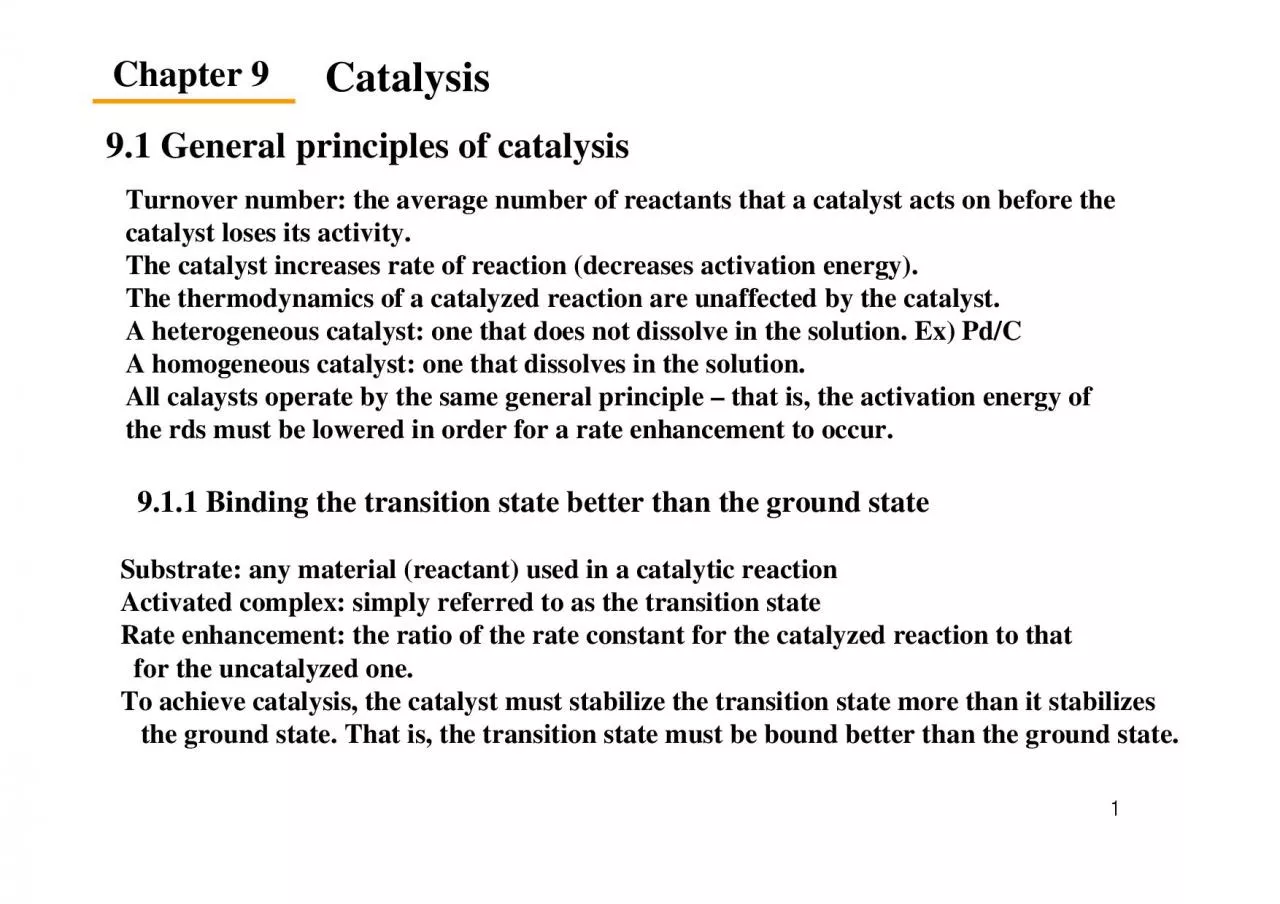

for the uncatalyzedoneTo achieve catalysis the catalyst must stabilize the transitionstate more than it stabilizes the ground state That is the transition state must be boundbetter than the ground ID: 939305
Download Pdf The PPT/PDF document "Turnover number the average number of re..." is the property of its rightful owner. Permission is granted to download and print the materials on this web site for personal, non-commercial use only, and to display it on your personal computer provided you do not modify the materials and that you retain all copyright notices contained in the materials. By downloading content from our website, you accept the terms of this agreement.
Turnover number: the average number of reactants that a catalystacts on before the The thermodynamics of a catalyzed reaction are unaffected by thecatalyst.All calaystsoperate by the same general princi
ple that is, the activation energy of the rdsmust be lowered in order for a rate enhancement to occur. for the uncatalyzedone.To achieve catalysis, the catalyst must stabilize the transitionstate more
than it stabilizes the ground state. That is, the transition state must be boundbetter than the ground state. 9.1.3 A spatial temporal approach To achieve catalysis, the catalyst must stabilize the tra
nsitionstate more than it stabilizes the ground state. That is, the transition state must be boundbetter than the ground state.Another explanation for catalysis: spatial temporal postulate, many intramo
lecularreactions 9.2.2 Proximity as binding phenomenon Intermolecular aminolysis(Intramolecularcyclization(Effective molarity(E.M.) or intramolecularity; ratio of the first order in the intramolecularr
eaction 1.3 x 10�- a rate enhancement of 1200 Entropies of translation and rotation Gem-dimethyleffect: stericallycompress two groups together and preorganize RRdecrease of angleclose �- i
nfinitely stable�- very reactive 9.2.3 ElectrophiliccatalysisElectrophiliccatalysis includes simple electrostatics, hydrogen bonding, acid catalysis,and electrophilicmetal coordination.Electrosta
tic interactions Oxyanionhole 150-fold rate enhancement Cation- 16-fold rate enhancement pKaof metal-bound water = 7.2 (10 9.2.4 Acid-base catalysis; 9.3ììì¤ëª 9.2.5 NucleophiliccatalysisNucleophil
iccatalysis arise when a nucleophilebinds to a reactant and enhances its rate NMe NH NMe DMAP; N,N'-dimethylaminopyridine better electrophileand more reactive 9.2.6 Covalent catalysis Iminiumion chara
ceristicsto the transition state, the substrate may distort in order to optimize binding 9.3 Brønstedacid-base catalysis is defined as the protonatedform of the solvent in which the reaction is is def
ined as the conjugate base of the solvent.eg) HO-, -CN, CH3-The specific acid catalysis refers to a process in which the reaction rate depends uponthe specific acid, not upon other acids in the solution
.The specific base catalysis refers to a process in which the reaction rate depends uponthe specific base, not upon other bases in the solution.kO+ added acid (AcOHin HIf the acid catalysis is involved
in an equilibrium prior to therds, and it is not involved ìê³¼ëì¼ ëë°ììê´ì¬íì§ìììí¬í¨ëì§ìì -][H3O+]/[HA]KaRH+= [R][H3O+]/[RH+][HA] íìì O+] -][H3O+]/[RH]BH+ëë°ì
ìê´ì¬íì§ìììí¬í¨ëì§ìì [B] íììììë¤ìì¤ëª Kinetic plots ecific base catalysis is thatthe rate depends on the pH and not on the concentration of various acids or bases.
Thisacid or base occur prior to rds, and the acid or base is not involved in rdsitself.specific acid catalysisspecific base catalysispecific base catalysis3O+]/KaRH+kobs= kKaRH/[H3O+]logkobs= logkpH-lo
gKaRH+logkobs= logk+pH+logKaRH+added acidadded base The term generalrefers to the fact that any acid or base we added to the solution The term specificrefers to the fact that just one acid or base,
that from the solvent, ëë°ììê´ì¬í¨ìí¬í¨ a= [A-O+[HA] or kO+a-Since the acid is always regenerated after the reaction, �its concentration never changes over the course of the reactio
n - pseudo-first order-the concentration of either HA or A-is in the rate expression. General acid catalyzed reactions ëë°ììê´ì¬í¨ìí¬í¨ [B] or kb-Since the base is always regenerated afte
r the reaction, �its concentration never changes over the course of the reaction - pseudo-first order-the concentration of either B or BH+is in the rate expression. Note: specificis used to de
signate the protonatedor deprotonatedform of the solvent However, sometimes hydroniumor hydroxide can be involved in rds. 19 page ì¤ì ë¡ë첫ë²ì§¸ë¨ê³ê°ë¡ìì© Kinetic plots ecific base catal
ysis is thatthe rate depends on the pH and not on the concentration of various acids or bases. Thisacid or base occur prior to rds, and the acid or base is not involved in rdsitself. general acid cataly
sisgeneral base catalysiseneral base catalysisk[H3O+][A-]/Kakobs= k[B] or k[HO-][HB+]/Kbíì´ì§20ê³¼ë¹êµë¡ì£¼ë¡ì¡´ì¬ìë³íììì´ê²ìë°ììê´ì¬íì§ììì´ê³µì¡´ê°ì ì°¨ì ì¼ë¡ë
¡ë°ëì´ê°ì§ã£ì ì¼ë¡ê°ã¢general acid catalysisgeneral base catalysis eral-acid-general-base catalysisBoth a general acid and a general base catalyst are required fora reaction. acidbase the p
roduct of the concentrations of 9.4.1 Michaelis-Mentenkineticsââk1âk-1kcatE·S: Michaeliscomplex S rate = d[P]/dt= d[ES]/dt= 0-[ES] Km+ [S]rate = d[P]/dt= Michaelis-MentenequationKinetic parame
ters to be determ physical processchemical process turnover number: the maximum number of substrate moleculesconverted to productsper active site per unit time product within the active site�- pr
oximity, acid-base catalysis, electrostatic consideration, covalent catalysis,and the cat: apparent dissociation constant that may be tof all enzyme-bound species.the dissociation constant for ES comple
x.Under these circumstances, the catalyst is. The smaller mean�s a better receptor. - physical process (binding) rather than a chemical transformation.(a very good catalyst) does not resemble the
dissociation constant for ES complex ; apparent second order rate constantnds the substrate and how well the catalyst turnsover the substrate to pr�oduct. - Information on both binding and catal
ysis 9.4.3 Enzyme active sites Proposed mechanismRicinA is a potent cytotoxinfrom attacks ribosomes, hydrolyzing the of specific adenosine nucleot�- enhances nucleophilicityof water Rate enhancem